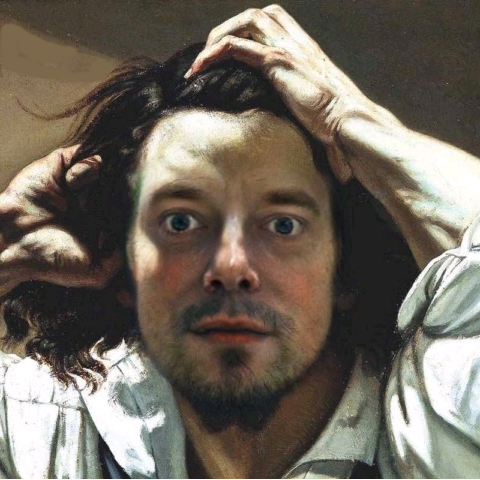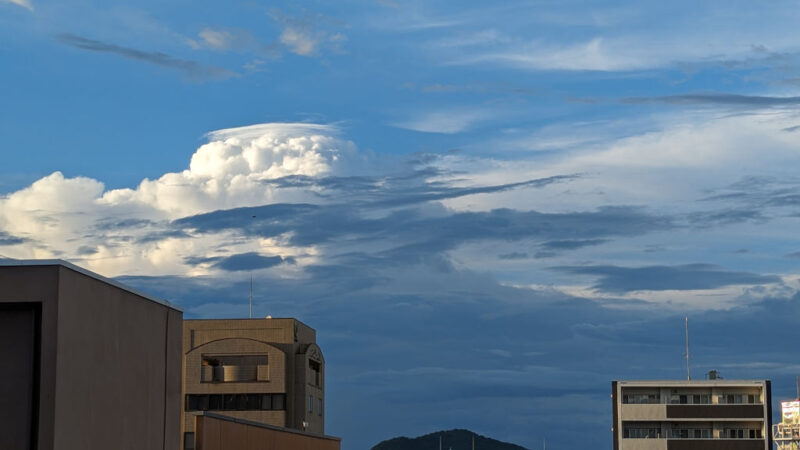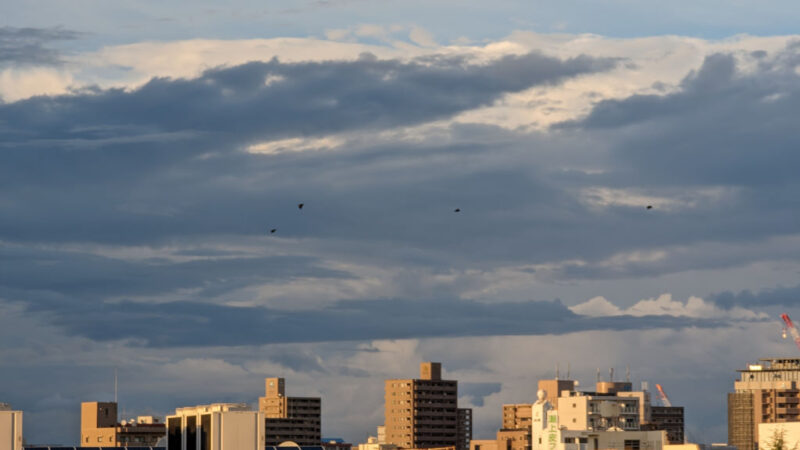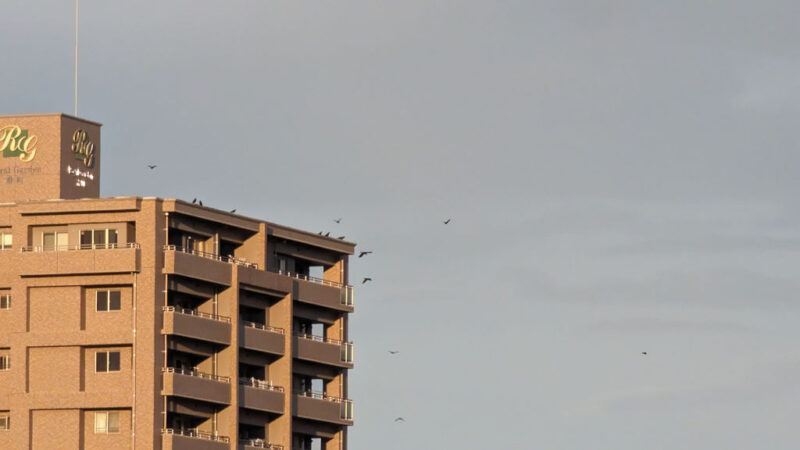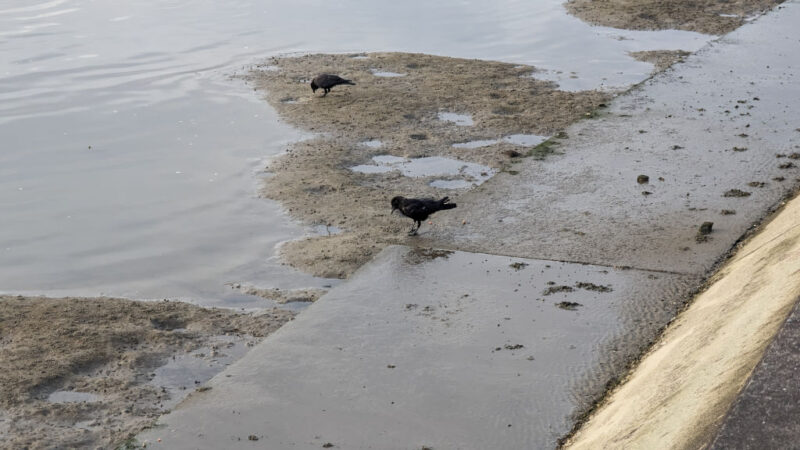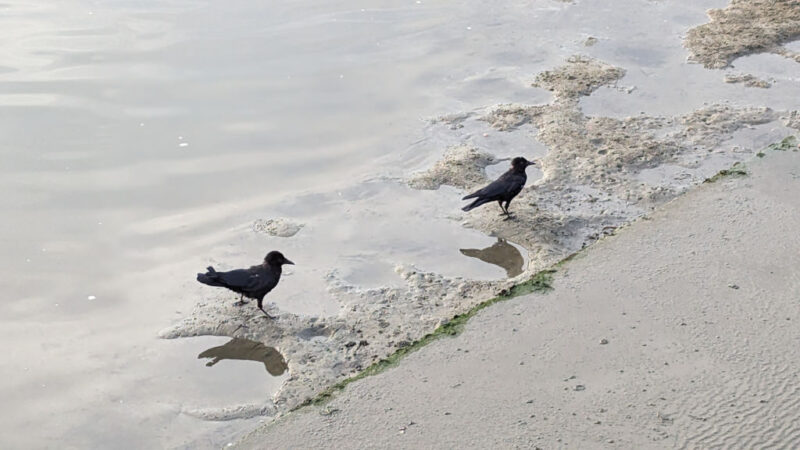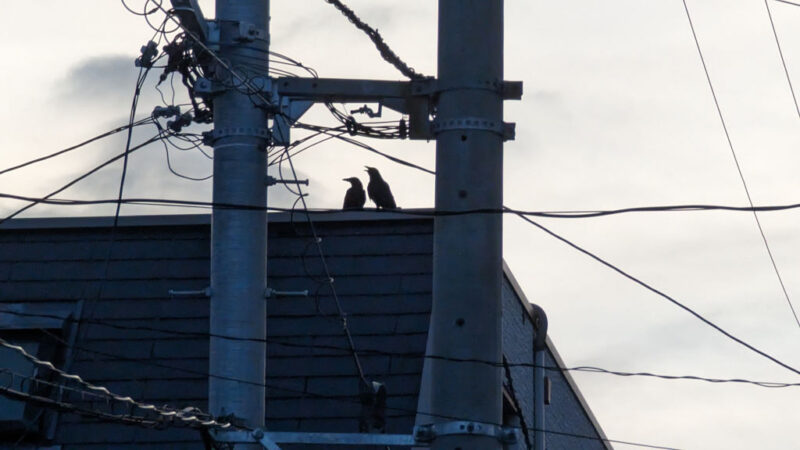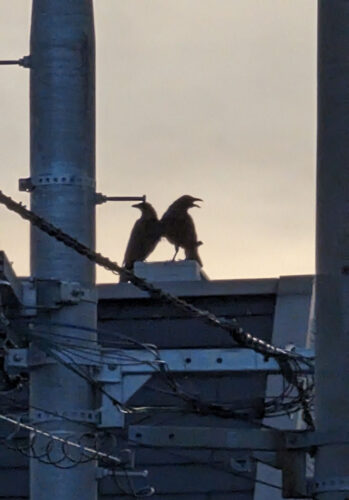You figured it out, this post will be about crows.
It was just supposed to be a small “crow update” that I post a few times a week, usually on Mastodon, but it started taking such proportions that it became a blog post. The current one.
It was not even supposed to be about crows.
See, this summer has been particularly hot as you may be aware, and cloud formations have been quite intense and interesting here. I don’t remember that many in the summer since I’ve been here, on the island of Shikoku in Western Japan. On the other hand, they have started to remind me of the ones I could see in Northern Florida back when I lived there. Is Western Japan’s climate becoming more like Florida’s? I wouldn’t be surprised.
In any case, the other day, I was in my office a little later than usual, and I took this picture:
Impressive cloud, right?
Did you notice the black dot on the picture?
Yes, it’s a crow photobombing my picture.
It was not alone:
Actually, more and more crows flew by. Sundown was 30 minutes or so away and well, it was something I hadn’t seen in a while, but something I surely had seen before. Crows were flying to bed.
Oh, you thought that they had a nest and slept there? Or on a tree in their territory? Well, it’s complicated.
A year in a crow’s life can be divided into roughly two periods. Nesting season and the rest of the year… But before I go into details, two disclaimers:
Disclaimer 1: I’m not a corvid specialist, and while I’ve learned a lot about them this year, I’m still nowhere near being “knowledgeable.” I’m just reporting my observations and matching them with what I learned.
Disclaimer 2: There are dozens of species of crows and ravens in the world (and the difference between both is mostly linguistical, not biological, but that’s for another day), I can only speak about the ones I’m familiar with. Two species live in my city:
- Carrion crows (Corvus corone): They are the crows in my neighborhood and around. They’re the ones I’ve been observing and that I’m the most familiar with. They are the same species as the common crows in Western Europe. However, they are a different species from American crows (Corvus brachyrhynchos) for those of you who live in North America. American crows only live in North America.
- Large-billed crows (Corvus macrorhynchos): They only live in East Asia. They seem to be the most common corvid in large cities in Japan, and while I regularly spot them downtown, there aren’t any near my house, and I’m not as familiar with them. From what I’ve heard their lifestyle is not so different from carrion crows.
Alright, so I was saying “nesting season” and “the rest of the year” (I’m sure that ornithologists have a word for it.) As you may know, if you’ve read my big “Crow update” from a couple of months ago, the nesting season ended at the end of June. And during nesting season, yes, crows do sleep in or near their nest, but not at the moment. When there is no egg or fledgling to take care of, crows all gather and sleep together at night. And when I say “gather” I mean large groups of hundreds, sometimes thousands of crows. This is where the imagery of those large group of crows come from. Why do they do that? First, it’s safer (safety in number and all that.) Also, crows are social animals, and I’m sure that it’s during these gatherings (I’m being told it’s called a roost) that they socialize with other crows, make friends, keep in touch with their family, and meet their future mates if they’re single. It sounds like I’m joking, but I’m not. There is some assuming involved in the previous sentence, but this is what they do for real.
So, yes, these crows, in the picture above, are flying to their roosting location.
We do have a problem, though.
For years (it started when I lived in a completely different neighborhood before I even really cared about crows), I assumed that they roosted on the big hills in the center of the city. But taking the picture above and the short video below, I realized that no, it wasn’t the case at all (okay, another disclaimer: some may, but not the crows in this part of town.)
See, in the picture above, they’re flying eastward. And the hill I mentioned is just a kilometer or so behind me as I took the picture, so it doesn’t make sense that they’d go East and not South from where I was.
Here too, they’re going full East, and once again, the hill is right behind me (we’re looking North, North-East here):
I also noticed something interesting. These crows in particular had a rallying point on top of a big apartment building nearby, where they’d gather, wait for more crows to come, and then fly together in a larger group.
Look:
Yes, that was very impressive and interesting, but if they don’t sleep on the hill as I thought for years: “Where do the crows in my city sleep?”
Well, somewhere east of campus, but where? In the park downtown? Isn’t it too small for that many crows? On the trees in “main street”? As far as I know, this is starling territory.
Where then?
It is something that needs investigation…
A few days later…
Shortly before sundown, I noticed that it was low tide. And do you know what low tide means this time of the year and of the day? It means many many crows in the estuaries. Humans are not the only ones to consider seafood to be a delicacy. So I went to the estuary closer to my house… Yes, I said estuaries, plural. It may sound surprising, but Japan – with its geography (it’s 70% mountains) – doesn’t have many big rivers. However, it makes up for the lack of big rivers with many small rivers. As a consequence, when you’re on the coast, you’re never too far from an estuary. If I’m correct, there are seven small rivers and as many estuaries in my city, including three not too far from me, two of them being within walking distance from my house. So, I went to the estuary closer to my house to film the crows there and hopefully see them flying in mass to their roosting location and have a nice video to show you.
Well, things didn’t go according to plan, because, as soon as I started filming I had an “encounter” and… well, watch…
But before, another disclaimer: this video is very poorly shot, I only had my phone and I suddenly had to improvise a lot, and well… I’m not a confirmed videographer, far from it.
So, watch at your own risk if you like good and polished videos:
Yes, “my” crows were right there, below me when I arrived. It was a total coincidence, but a very pleasant one. Because of that, I barely shot the other crows flying away, but it was great to observe and film my buddies in a different context than the park near my home.
I love how they raise the feathers on their heads, a bit like humans frown their eyebrows to tell the other crows to back off. After all, the other crows are probably friends or even family, but those peanuts are not to be shared with anyone else.
All this time spent with them meant that they could miss the signal to fly to their roosting location. I was a bit afraid of that, but as it seemed there was still some time left (some crows were still in the estuary), I was curious to see if they would follow me to the park. When I started walking toward it, they left the estuary and separately flew to the roofs of two separate buildings next to each other. I’m not sure – I’m never sure – but it felt like one of them (Mr. Crow?) was ready to follow me, but the other one was more concerned with sunset approaching (most diurnal birds don’t have good night vision – if at all – I don’t exactly know for crows, but I never saw any flying after sunset.)
They soon met on a third roof, right above me, and the three of us stayed there, between the estuary and the park, for a few minutes. I could shoot these two interesting pictures.
I left a peanut in the street, but they didn’t pick it up, or at least not while I was there.
I decided that it was better to stop distracting them, the sky was getting darker. I walked home quickly and as soon as I arrived on my balcony, I saw them both flying eastward to meet their friends and family for the night (sorry no picture.)
So, yes, nothing too special happened, but I thought it was a nice anecdote.
I hope you like it. If you want more crow updates, you should follow me on Mastodon. And don’t listen to the naysayers, the Fediverse really is one of the best things to happen to the internet in years. Actually, I will probably write more about the current state of social media soon. You should subscribe to this blog if you’re interested in this topic or all the various things I talk about here.
Okay, it’s the evening, the sun will set in less than one hour, and I already see the campus crows starting to gather, so I’ll talk to you later.
Oh, I almost forgot, between the moment I filmed and shot what you saw above and the moment I typed this text (that is right now) I have found where the crows roost. You may be surprised… or not (you can post your guesses in the comments, I will not tell you if you’re right or wrong, but I’m curious about what you think)…
In any case, it’ll be for another day, as I need visual evidence to show you.
Alright, talk soon.
Stay safe and take care.
